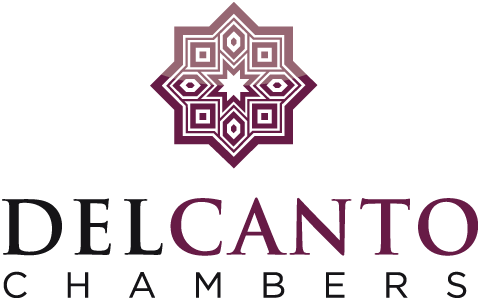Tax & Legal Services
Intellectual Property

We are passionate about Intellectual Property (IP) at Del Canto Chambers and have been advising on this complex area for decades. The protection and monetisation of Intellectual Property are all essential parts of our work.
We get involved from registration to restructuring of Intellectual Property portfolio to complex disputes and resolution. Our clients range from individual creators, inventors and artists, SMEs to international corporations and other organisations, including not-for-profit foundations.
Intellectual Property Services
Regularly instructed by artists and sports people, franchise businesses, media companies and entertainment lawyers, Del Canto Chambers advises on all aspects of Intellectual Property including:
- Planning strategies for Intellectual Property
- Intellectual Property ownership and registration
- Usage, marketing and distribution agreements of Intellectual Property
- Commercial viability/ joint ventures
- Franchising
- Protection of Intellectual Property
- Infringement or disputes regarding Intellectual Property
We have advised and represented many well-known brands, from indie cinema productions to luxury yachts, premiership football clubs, telecommunications companies, charitable organisations, franchises and many more in relation to the preservation, protection, dissemination and enforcement of their Intellectual Property Rights.
Intellectual Property (IP)
Intellectual Property law governs the ownership of ideas and inventions and is an integral part of most businesses. There are many different ways of protecting Intellectual Property but the three main forms are:
- Trademarks – a sign capable of distinguishing the goods or services of one enterprise from those of other enterprises.
- Copyrights – a term used to describe the rights that creators have over their literary and artistic works. Works covered by copyright range from books, music, paintings, sculpture, and films, to computer programs, databases, advertisements, maps, and technical drawings.
- Patents – an exclusive right granted for an invention, which is a product or a process that provides, in general, a new way of doing something, or offers a new technical solution to a problem. To get a patent, technical information about the invention must be disclosed to the public in a patent application.
It is important to determine the categories of intangible assets to be protected by Intellectual Property, including the following categories, as determined by the WIPO (World Intellectual Property Organization)
It includes generally: inventions, literary and artistic works and designs, but also commercial symbols, names and images.
- Innovative products and processes, including some of the aspects of our business Know- How and even well established and innovative protocols (through patents and utility models). Over the years, and especially in a digital economy, there has been an increased interest in protecting a myriad of processes and models. It is worth noting that around 95% of the world’s utility model applications are filed in China, totalling more than 50% of the number of utility patent applications filed worldwide as reported by WIPO;
- Cultural, artistic and literary works including, in most countries, computer software and compilation of data (through copyright and related rights protection). One of the areas where we have been involved is in the discussion of some forms of Yoga and copyrights.
- Creative designs, including textile designs (through industrial design rights). We worked with an interesting Sotogrande based designer who brought some of the ancient Ottoman designs into modern textiles.
- Distinctive signs may be protected, mostly through trademarks including collective and certification marks, but in some cases through geographical indications too.
- Domain name disputes, arising largely from the practice of cybersquatting, which involves the pre-emptive registration of trademarks by third parties as domain names. Cybersquatters exploit the first-come, first-served nature of the domain name registration system to register names of trademarks, famous people or businesses with which they have no connection.
- Microchips through the protection of layout-designs or topographies of integrated circuits;
- Denominations for goods of a given quality or reputation attributable to the geographical origin (through protection of geographical indication) as it has been done profusely with many foods and wines in Spain, as it was done by the Sherry county in Andalucia; and
- Trade secrets through the protection of undisclosed information and confidential information of commercial value.
Why is Intellectual Property Important?
Intellectual Property is critical to the protection of ideas and the fostering of creativity and innovation for both artists and businesses. Intellectual property is incredibly valuable, and should not be merely regarded as a commodity – it must be understood as a creation of the mind, in most cases for the advancement of society.
“There is a tremendous diversity of responses to the growing importance of intellectual property on the part of firms. In many cases, firms have ignored the increased role of intellectual property in today’s economy for too long, and have failed to adopt strategies to monetise their holdings. In other cases, however, companies have adopted “scorched earth” policies that aim to confront and litigate with rivals about intellectual property, which have often proved to be counterproductive as well.”
Josh Lerner, Jacob H. Schiff Professor of Investment Banking at Harvard Business School.
One out of every three jobs in the EU is supported by industries that make intensive use of Intellectual Property rights such as trademarks, copyright, designs and patents. The Intellectual Property rights-intensive industries account for more than 42 % of total economic activity in the EU (approximately EUR 5.7 trillion of the EU’s GDP).
Intellectual Property Rights
If you hold Intellectual Property rights you are usually given an exclusive right over the use of that Intellectual Property for a certain period of time:
- Copyright gives the creators of literature or artistic works protection for a minimum period of 50 years after the originator’s death.
- The protection of distinctive signs is normally through trademarks and may last indefinitely, provided the sign in question is registered correctly continues to be distinctive.
- Intellectual Property such as inventions are normally protected by patents for a finite term, typically 20 years.
How can we help protect your international intellectual property
Our expertise in advising on the best strategies for obtaining and enforcing intellectual property rights sets us apart from other firms. As members of The Leading Edge Alliance, we work collaboratively with LEA Global firms, with a strong focus on client service.
To make a no-obligation enquiry, please call us on +353 021 424 4116 or fill out the form below
